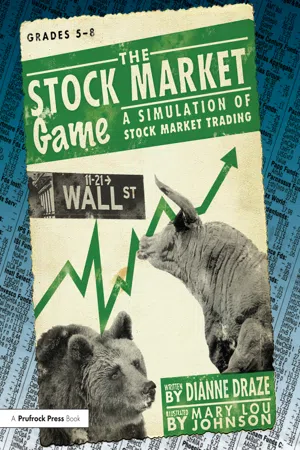
- 66 pages
- English
- ePUB (mobile friendly)
- Available on iOS & Android
About this book
The stock market is in the news every day, and even people who do not personally trade securities or intend to make a fortune by trading stocks have an interest in knowing something about the stock market. By giving students an understanding of the stock market, we are preparing them to deal knowledgeably with an area of our society that has a vast effect on their lives. Whether or not they choose later in life to trade stocks on an individual basis, they will have the knowledge that will enable them to understand this aspect of the economy and how their personal economic pictures are affected by the larger economic landscape.
The Stock Market Game is a fun, informative simulation game that provides the information and framework for students to learn about the economics and psychology of the stock market. This easy-to-use guide includes:
- information about all aspects of company ownership;
- information on stocks, stock prices, the stock market, buying and selling stocks, and forces that affect stock prices;
- a minisimulation that can be completed in 1 week; and
- a longer simulation that follows the real stock market for several months.
All information is presented on reproducible pages, illustrated with examples, and followed by exercises that let students apply their knowledge. This motivating unit will give students insights they will carry with them into their adult lives. This combination curriculum guide/simulation has it all. All you have to do is add current stock prices from your newspaper or the Internet.
For more information on business ownership, use the simulation Open for Business.
Grades 5-8
Frequently asked questions
- Essential is ideal for learners and professionals who enjoy exploring a wide range of subjects. Access the Essential Library with 800,000+ trusted titles and best-sellers across business, personal growth, and the humanities. Includes unlimited reading time and Standard Read Aloud voice.
- Complete: Perfect for advanced learners and researchers needing full, unrestricted access. Unlock 1.4M+ books across hundreds of subjects, including academic and specialized titles. The Complete Plan also includes advanced features like Premium Read Aloud and Research Assistant.
Please note we cannot support devices running on iOS 13 and Android 7 or earlier. Learn more about using the app.
Information
Stock Market Game
Short Version
Overview
Procedure
Day 1
- Duplicate and pass out the company profiles. Go through each company profile and discuss the products or services it offers. Explain to students that they will be making their stock purchases from these companies. After they choose their initial purchases, they will be given a chance each day to buy or sell stocks.
- Review how to figure purchase or sale price (stock price x number of shares) and commission (total price x commission rate).
- Give students copies of the Trading Record, Portfolio Record, and Cash Reserve sheets. These sheets are used to keep track of the stocks that they buy and sell and the money they have in their reserve accounts. Go through an example together, showing students how to record purchases and sales and how to transfer them to their stock portfolios and cash reserve sheets. See examples on pages 61 to 63.
- Review rules of the simulation with students. The rules are:
- They have $50,000 with which to purchase stock.
- They have to own at least two different stocks.
- They cannot own more than 500 shares of any one stock.
- They have to buy and sell in multiples of 100.
- They must sell at least 100 shares and buy 100 shares of a new stock each trading period.
- They must pay a commission of 3% on all stock purchases and sales.
- Money that is not invested in stocks will be held in a cash reserve account. When stocks are sold, the money from the sales goes into the cash reserve account. They can never spend more money than they have in the cash account to buy new stocks.
- While it is not a rule of the game, encourage students to limit their stock choices to no more than five stocks. If they own more than five stocks, it becomes difficult for them to follow the stocks and keep track of the money transactions.
- Post the beginning prices for the stocks.
- Have students select their stocks and record them on their Trading Record and Stock Portfolio sheets. They may not spend more than $50,000. Money that they have left over after purchasing stocks will be recorded on their Cash Reserve sheet. They will keep a continuing record of their cash reserve on this record sheets. For complete instructions on recording transactions, see page 52. For examples showing how to record information on the various records sheets, see pages 61 to 63.
- Read the first news report.
Day 2
- Read the early edition news report.
- Post the daily stock prices.
- Give students time to decide which stocks they want to buy and sell. Have them record their sales and purchases on their Trading Records and then transfer the information to the Stock Portfolio. Any changes in their cash reserv...
Table of contents
- Cover
- Title Page
- Copyright Page
- Contents
- Information for the Instructor
- Glossary of Terms
- Business Ownership
- Stock Prices
- Look It Up
- Making Money with Stocks
- Stock Exchanges
- Benchmarks
- Stockbrokers and Commissions
- Buying Stocks
- How to Pick a Winner
- The Stock Market Game (Short Version)
- The Stock Market Game (Long Version)
- Answers